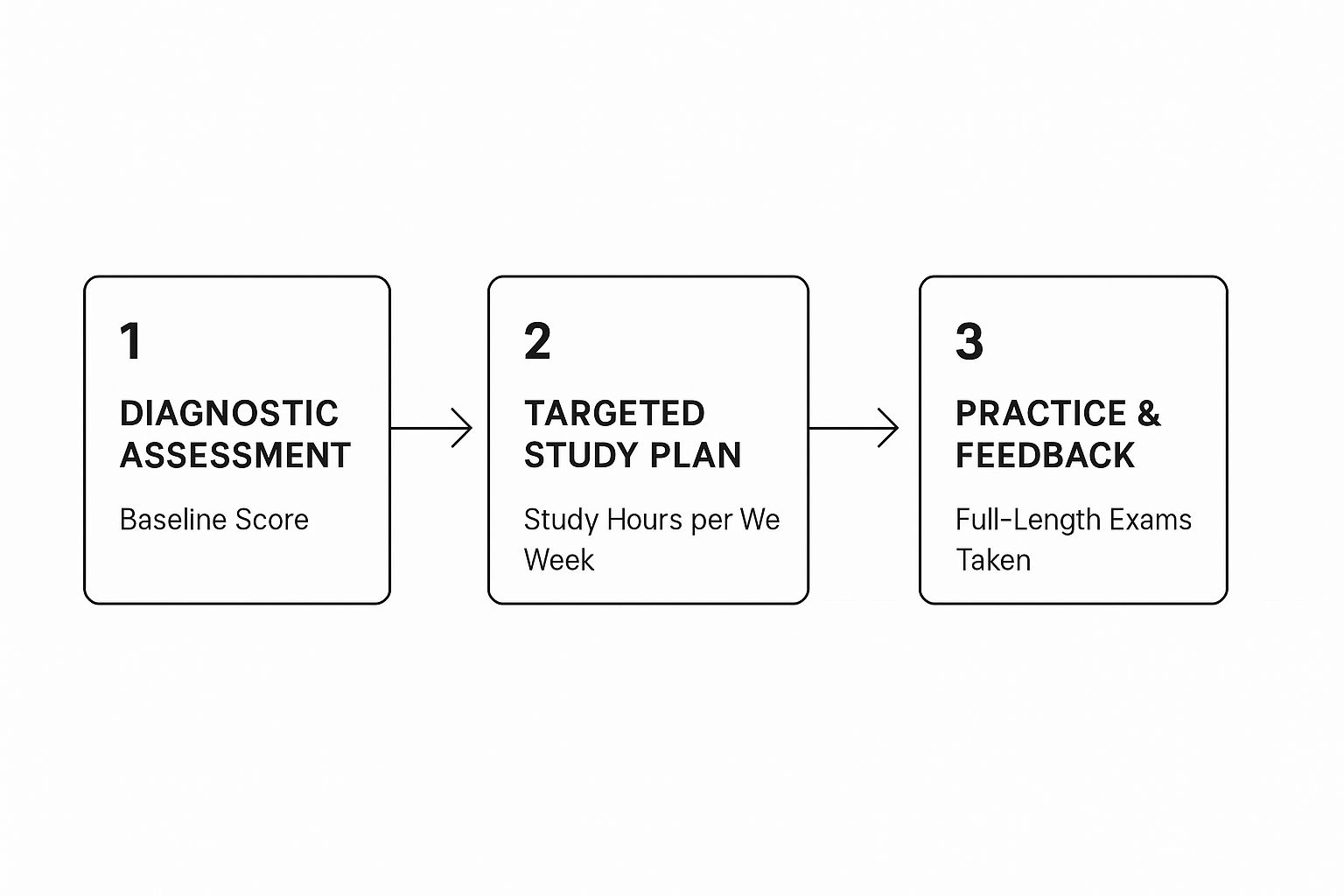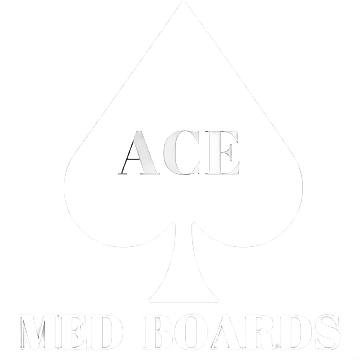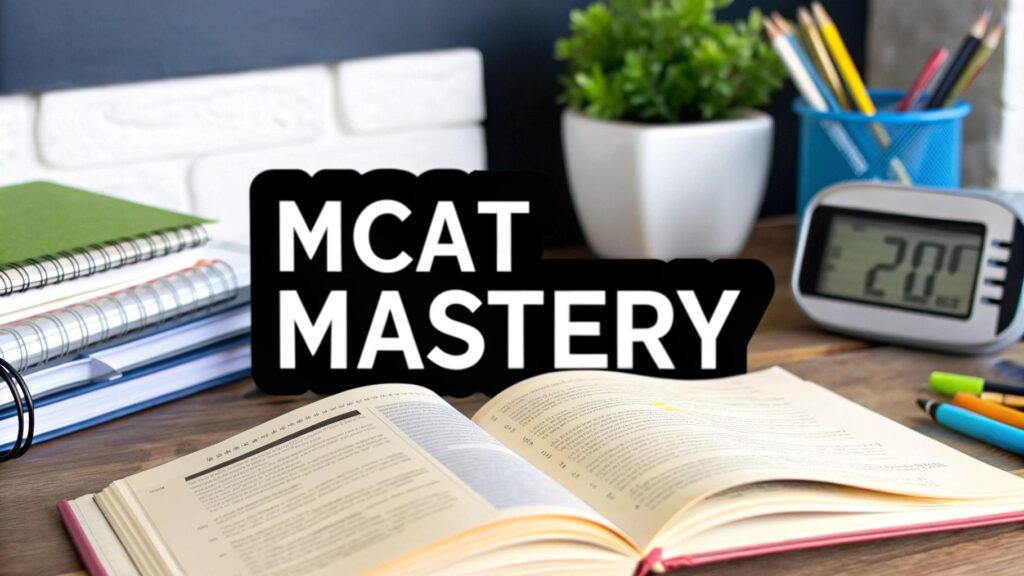If you’re trying to raise your MCAT score, the solution isn't just logging more study hours. So many students fall into the trap of thinking that more time equals a better result, but the truth is, how you study matters far more than how long you do it. The path to a significant score jump is all about being strategic.
It's a repeatable process, one that moves you from passively reviewing material to actively targeting your weaknesses. This starts with getting an honest look at where you stand right now. From that baseline, you can build a focused plan that turns your weak points into strengths, building not just your knowledge but also the confidence and endurance you need for test day.
Think of it as a cycle of continuous improvement. You assess, plan, practice, and then analyze your performance to refine your approach all over again.

This entire process rests on four core pillars. Getting a handle on these is what separates the top scorers from everyone else. They work together, so you can't afford to neglect any one of them.
This table gives a high-level overview of the strategic pillars that will form the foundation of your study plan.
Four Pillars of MCAT Score Improvement
| Pillar | Objective | Key Actions |
|---|---|---|
| Pinpoint Weaknesses | Establish an accurate performance baseline. | Take a full-length diagnostic test under realistic conditions to identify specific content gaps and pacing issues. |
| Master High-Yield Content | Focus study time on what matters most. | Use diagnostic results to guide active learning, prioritizing high-yield topics where you lost the most points. |
| Build Stamina | Develop the endurance for a 7.5-hour exam. | Take full-length practice tests regularly to get used to the timing, format, and mental fatigue of the real MCAT. |
| Analyze Performance | Learn from every single mistake. | Conduct a detailed review after each practice test to understand why you got questions wrong and identify patterns. |
Mastering these pillars creates a powerful feedback loop. You diagnose, study, practice, and analyze—then you repeat the process, getting a little sharper each time.
This strategic framework also helps put your score goals into perspective. According to AAMC data from recent years, the average MCAT score is around 501. Pushing your score above 508 puts you in the competitive 75th percentile, a move that can significantly strengthen your medical school application.
To put these pillars into action, you'll need a solid schedule. For a detailed guide on mapping out your study weeks, check out our post on creating a powerful MCAT study schedule.
Stop Reading, Start Doing: Mastering Content with Active Learning

Here's the single biggest mistake I see students make during content review: they confuse familiarity with actual understanding. It's a trap. You can read a chapter on glycolysis ten times and feel like an expert, but that feeling is often just an illusion.
True mastery—the kind that lets you nail those complex, application-based MCAT questions—comes from active learning, not passively staring at your textbook. Highlighting, re-reading, and watching videos without engaging your brain are comfort traps. They feel productive, but they don't build the strong neural pathways you need for exam day.
Active learning forces your brain to retrieve and apply information. It’s where you’ll see the most significant score gains. For instance, when you're tackling a metabolic pathway, don't just look at the diagram. Close the book and draw it from memory. Try explaining each step out loud like you're teaching it to a friend. This simple shift immediately exposes what you actually know versus what you just thought you knew.
The Feynman Technique: Your Secret Weapon for Deep Understanding
One of the most powerful active learning strategies is the Feynman Technique. It’s a beautifully simple but effective mental model for breaking down tough topics. The goal is to explain a concept in the simplest terms possible, which brutally exposes any gaps in your knowledge.
Here’s how you can put it to work right now:
- Pick a Concept: Grab a single topic from your diagnostic report that gave you trouble, like the function of the sodium-potassium pump.
- Teach It to a Newbie: On a blank piece of paper, write down an explanation as if you were teaching it to a middle schooler. No jargon. No complex terms.
- Spot the Gaps: Anytime you get stuck, stumble, or have to use fancy language, that's it. You've found a weak spot where your understanding crumbles.
- Fill the Hole and Simplify: Go back to your study materials—your textbook, a video, whatever—to fill in that specific gap. Then, try your simple explanation again.
This method transforms studying from a passive act of consumption into an active process of building knowledge. When you can explain a topic simply and accurately, you truly own it.
Spaced Repetition and High-Yield Focus
Your brain is literally wired to forget things. It’s a feature, not a bug. To fight this natural "forgetting curve," you have to use spaced repetition. This technique involves reviewing information at increasing intervals, which has been proven time and again to lock knowledge into your long-term memory.
The best tool for this is a flashcard program like Anki. It uses a smart algorithm to show you cards right before you're about to forget them. Instead of trying to cram hundreds of facts in one go, Anki helps you efficiently review thousands of concepts over your entire study period.
Key Takeaway: Don't waste time making flashcards for every single detail. Laser-focus on high-yield topics—the concepts that show up most often on the MCAT. Your diagnostic report is your treasure map for finding the high-yield areas where you are weakest.
You also need to weave practice questions into your daily content review. Don’t hoard them for the final weeks. After studying a topic like acids and bases, immediately do a set of 10-15 practice questions on that subject. This connects the abstract concepts to how they're actually tested and builds a critical skill you'll lean on heavily in medical school. You can learn more about why this works by exploring the power of active recall for medical students—it’s a principle that will serve you for your entire career.
By shifting from passive review to these active strategies, you stop wasting time on what you already know and start building a deeper, more flexible understanding of the material. This isn't just about studying harder; it's about studying smarter.
Perfecting Your Practice and Building Test Day Stamina

Knowing the science for the MCAT is a huge achievement, but it's only half the battle. What truly separates a good score from a great one is your ability to apply that knowledge under immense pressure during a grueling 7.5-hour exam. This is where building unshakable test day stamina becomes just as critical as knowing the Krebs cycle.
Think of it like training for a marathon. You wouldn't just read books about running; you'd get out there and run, slowly increasing your mileage and simulating race-day conditions. The MCAT is no different. Consistent, realistic practice is what transforms all that hard-earned knowledge into a powerful, score-boosting skill set.
This means moving beyond random question sets. You need to embrace full-length practice exams as a core part of your prep. The goal isn't just to quiz yourself—it's to build the mental and physical endurance required to stay sharp from the very first question to the last.
Strategically Using Your Practice Exams
Not all practice exams are created equal, and knowing how and when to use them is the secret to an effective study plan. It’s smart to use a mix of third-party exams and the official AAMC materials, but they serve different purposes at different stages of your prep.
Third-Party Exams (Blueprint, UWorld, etc.)
Think of these as your training ground. Use them in the earlier and middle stages of your prep. Their main job is to help you build raw stamina and flag any big, glaring content weaknesses.
These exams, from providers like Blueprint or UWorld, often provide a massive volume of questions. Some are even designed to be a bit tougher than the real MCAT, which is great for over-preparing on content and pacing. Schedule one every 1-2 weeks. Use them to get comfortable with the 7.5-hour duration, master your break time, and nail down your pacing for each section.
AAMC Official Materials
These are the crown jewels of MCAT prep and should be treated as such. Save the AAMC full-length exams for the final 4-6 weeks before your test date.
Why? Because nothing replicates the unique logic, passage style, and question difficulty of the real MCAT like the official materials from the test-makers themselves. Your scores on these exams are the most accurate predictors of how you'll perform on the big day. Take them under the most realistic conditions possible—start at the same time as your actual exam, take your scheduled breaks religiously, and eliminate all distractions.
Expert Tip: Never "waste" an AAMC exam. Before you sit for your first one, make sure you've covered a significant portion of your content review. Taking it too early just wastes your most valuable predictive tool and won't give you an accurate picture of your potential.
Performing a Ruthless Test Autopsy
Here’s the biggest mistake I see students make: they finish a practice test, peek at their score, and immediately move on. The real learning, the kind that leads to score jumps, happens after the exam during what I call a "test autopsy."
A test autopsy goes way beyond just checking which answers were wrong. It's a deep-dive investigation into the root cause of every single error. For every question you missed—and even the ones you guessed on correctly—you have to ask yourself why you missed it.
I recommend creating a simple spreadsheet to track your mistakes. The columns should force you to be brutally honest with yourself.
| Question Number | Error Category | Specific Topic | My Thought Process | What I'll Do Differently |
|---|---|---|---|---|
| C/P #24 | Content Gap | Electrochemistry | I completely forgot the formula for Gibbs free energy from cell potential. | Re-watch Khan Academy video on galvanic cells and create 5 Anki cards. |
| CARS #12 | Misread Question | Author's Tone | The question asked what the author would least agree with, and I answered what they would agree with. | Slow down and highlight keywords like "NOT," "LEAST," or "EXCEPT" in the question stem. |
| B/B #38 | Timing Mistake | Enzyme Kinetics | I spent 3 minutes on this question and rushed the last few. I should have flagged it. | Practice flagging questions I'm not 100% on within 90 seconds and returning later. |
| P/S #51 | Overthinking | Social Theories | I correctly identified the answer but changed it because I thought it was "too obvious." | Trust my gut instinct on P/S questions, especially when I can immediately justify the first choice. |
Yes, this process is tedious. But it is the single most effective way to turn your weaknesses into strengths.
After just a couple of exams, you'll start seeing clear patterns. Maybe you consistently misinterpret graphs, or perhaps you always fall for "extreme" answer choices in CARS passages. This data-driven insight is what makes your next study session ruthlessly efficient. Instead of generically reviewing "biochemistry," you'll know you need to focus on amino acid structures because your log shows you missed 80% of those questions. This is how you make targeted, measurable improvements to your MCAT score.
Advanced Strategies for the CARS Section
Let's talk about CARS. The Critical Analysis and Reasoning Skills section is the great equalizer of the MCAT. It’s that one part of the test where your deep knowledge of organic chemistry or physics just won’t save you.
Instead, CARS tests a skill: your ability to dissect dense, unfamiliar arguments under intense time pressure. This is precisely why so many high-achieving science students find their scores hitting a frustrating plateau here. To break through, you need a battle plan built on technique, not just rote memorization.
Success in CARS comes from building a repeatable system for reading and reasoning. It’s less about becoming a speed-reader and more about becoming an efficient reader who actively engages with the text. Your goal isn't to become an expert on 18th-century philosophy in ten minutes; it's to map the author's argument, get a feel for their tone, and anticipate the kinds of questions the test-makers are likely to throw at you. This requires a mental shift from absorbing facts to analyzing structure.
Deconstructing the Author's Argument
At the heart of every CARS passage is an argument. The author is trying to convince you of something, even if it's subtle. Your first job is to figure out what that is. So, instead of just reading for information, read to pinpoint the author's main point and how they back it up.
A fantastic way to practice this is to pause after each paragraph and ask yourself what its job is. Try to summarize its purpose in a single, simple sentence.
- Is this paragraph introducing the main idea?
- Is it giving an example to support a claim made earlier?
- Is it bringing up a counter-argument that the author is about to tear down?
- Is it just wrapping things up?
By creating this mental "map" as you read, the passage stops being a wall of text and starts looking like a structured argument. You'll find it so much easier to hunt down answers because you'll know exactly where the author laid out their main claim versus where they put the supporting evidence.
Pro Tip: Keep an eye out for transition words. Phrases like "however," "therefore," "in contrast," and "consequently" are absolute gold. They are signposts that reveal the structure and flow of the argument, often signaling a major conclusion or a shift in perspective.
This analytical approach forces you to engage with the passage on a much deeper level. You’re no longer a passive reader; you're an active detective, uncovering the author's intent and strategy. For a deeper dive into building this skill, our guide offers more ways to improve your CARS score on the MCAT with targeted practice.
Spotting and Avoiding Common Answer Traps
Knowing the passage inside and out is only half the battle. You also have to navigate the minefield of tricky answer choices designed to mislead you. The AAMC is masterful at creating options that sound plausible but are dead wrong. Learning to spot these common traps is crucial for anyone looking to boost their CARS score.
Here are the most common traps you'll run into:
| Trap Type | Description | How to Avoid It |
|---|---|---|
| Too Extreme | Uses absolute words like "always," "never," "every," or "impossible." Nuanced passages rarely support such strong claims. | Be immediately suspicious of any answer that makes an absolute claim. Scan the passage to see if the author used equally strong language to justify it. They usually don't. |
| Out of Scope | Introduces information or ideas that weren't mentioned in the passage. The statement might even be true in the real world, but it isn't supported by the text. | Ask yourself: "Can I point to a specific sentence in the passage that backs this up?" If the answer is no, it's out of scope. |
| Logical Opposite | States the exact opposite of what the author argued. This trap catches students who misread the author's overall stance or a key detail. | Double-check your "argument map." Does this answer choice align with the author's main point, or does it directly contradict it? |
By consciously looking for these traps during your practice sessions, you'll develop a reliable gut feeling for eliminating them with confidence. This turns the process from a stressful 50/50 guess into a logical deduction, giving you a systematic way to find the correct answer nearly every time.
Analyzing Your Performance for Maximum Gains
Taking one practice test after another without deep analysis is like running on a treadmill and hoping you’ll end up somewhere new. You’ll definitely feel exhausted, but your score won’t actually go anywhere. You can’t make progress if you keep repeating the same mistakes, and your score will inevitably hit a wall.
Real progress—the kind that leads to those satisfying score jumps—comes from digging into the why behind your mistakes. This means shifting your mindset from just marking answers wrong to becoming a detective of your own thought process. It’s about data, not drama. After a tough practice exam, it’s easy to get discouraged. But that score is just a single data point; the real treasure is the mountain of information hidden in your errors.
Creating Your High-Impact Error Log
To unearth this information, you need to build and maintain a detailed error log. This is so much more than a simple list of wrong answers; it’s your personal diagnostic tool. A basic spreadsheet is perfect for this. For every single question you get wrong—and every one you guessed on correctly—you have to log it and break it down.
A good error log forces you to categorize each mistake, pushing you to find the root cause. This is how you move from generic, inefficient review to targeted, high-impact study sessions.
Here are the essential columns your log needs:
- Question Source: (e.g., AAMC FL #2, C/P #15)
- Error Type: (e.g., Content Gap, Misread Question, Calculation Error, Timing Mistake)
- Specific Topic: (e.g., Amino acid pKa values, lens formula, Piaget's stages)
- Your Reasoning: Why did you pick your answer? Be brutally honest here.
- Correct Reasoning: Explain in your own words why the right answer is correct.
- Action Plan: What specific, concrete step will you take to fix this? (e.g., "Review Chapter 5 of Kaplan Biochem," "Do 10 practice questions on circuits.")
After just two or three fully reviewed exams, you’ll start seeing patterns. Maybe you realize you consistently miss questions about experimental design, or you always mix up "most likely" versus "always true" qualifiers in the question stems. This is the kind of insight that truly boosts your MCAT score because you’re fixing the core problem, not just the symptom.
The Mental Game: The whole point of an error log is to use data, not emotion, to guide your next steps. A low score isn't a judgment of your potential; it's a diagnostic report telling you exactly where to focus your energy for the biggest gains.
Putting Your Analysis into Action
Reviewing your performance is also about keeping things in perspective. It's important to remember that the MCAT is just one part of a much bigger journey. While top scores are impressive, they aren't the only predictor of success in medical school.
In fact, one study showed that 84% of students who scored in the middle third of the old MCAT graduated medical school in four years. That’s remarkably close to the 89% graduation rate for students in the top third. You can learn more about how different scores relate to med school success in this detailed academic report.
This data-driven mindset is the key. Use your performance analysis to build a targeted plan. If your log screams weakness in metabolic pathways, dedicate your next two study blocks to that topic. If timing is the culprit, start weaving timed practice sets into your daily routine. This analytical, evidence-based approach is exactly how you break through plateaus and get to your target score.
Deciding to Retake the MCAT: A Strategic Choice

Getting an MCAT score that doesn't meet your expectations is a tough pill to swallow. It's easy to get swept up in disappointment, but your most critical task right now is to make a logical decision, not an emotional one. The real question isn't just if you should retake the exam, but why you fell short and how you'll guarantee a better outcome.
Before even thinking about re-registering, you need a completely honest look at your situation. Start by comparing your score to the median MCAT scores of the medical schools on your list. Is your score well below their average for matriculants? A gap of 5 or more points often makes a retake a strategic necessity.
If you see a significant gap, the next step is to ask yourself if you have a realistic shot at closing it. This requires some serious self-assessment.
Evaluating Your Retake Potential
Think back to your first round of prep. What went wrong? Were there specific content areas you neglected? Did you consistently run out of time on practice exams, or did you hit a wall and burn out in the final weeks?
Pinpointing these factors is everything. Simply repeating the same study plan is a surefire way to get the same result.
A retake is only a smart move if you have a concrete, actionable plan to change your entire approach. This might mean:
- A new study method: Switching from just reading notes to active learning techniques.
- More dedicated time: Committing to a longer, more structured, and realistic study period.
- Different resources: Investing in new practice materials, a tutor, or a course to attack your weak spots.
A common pitfall for retakers is underestimating the sheer effort needed for a big score jump. You have to find the root cause of your previous score and build an entirely new strategy to fix it.
What the Data Says About Retaking
Taking the MCAT again is a well-trodden path. In fact, about 26% of all test-takers decide to give it another shot. The good news? The data shows it often pays off.
Around 60% of retakers improve their score, with the average gain hovering around 2 to 3 points.
But here's where it gets interesting. Those who truly commit to a more intense and structured prep schedule see much better results. Students who dedicate at least three months to studying before a retake often see a more significant 4-point increase. You can dig into more of these numbers and trends from MCAT retake statistics and trends.
This data makes one thing clear: a successful retake isn’t just about having another go. It's about a more dedicated, strategic, and intense preparation period.
Ultimately, the choice is yours. It hinges on your goals, your first score, and your genuine capacity to prepare differently. If you can identify clear reasons for your performance and map out a robust, new plan to improve your MCAT score, a retake can be a powerful step toward your medical school ambitions.
Common MCAT Improvement Questions Answered
When you're grinding through MCAT prep, it’s easy to get tunnel vision. You're so focused on the next chapter or practice set that you forget to zoom out and ask the big-picture questions. Let’s tackle some of the most common—and nagging—questions that pop up when you're trying to boost that score.
How Long Does It Realistically Take to Improve?
There’s no magic number here. How long it takes really hinges on where you're starting from and what your goal score is. That said, a solid benchmark to aim for is 300-350 hours of focused, high-quality study. Most students spread this out over three to six months.
If you’re staring down a major score jump—think 10 points or more—you'll want to plan for a longer timeline. The key isn't just marking days off the calendar; it's about how effective those study hours actually are. Consistent, dedicated effort is what moves the needle.
What if My Practice Scores Aren't Improving?
First, take a breath. Hitting a score plateau is incredibly common and unbelievably frustrating. But it's not a dead end. Think of it as a signal from your study plan that something needs to change. Simply taking more and more practice tests hoping for a different outcome is a recipe for burnout. It's time to stop grinding and start investigating.
A score plateau isn’t a judgment on your potential. It's a data point telling you it's time to shift your strategy from sheer volume to smart analysis.
Become a detective with your last few exams. Dig deep. Are your mistakes clustered in one section? Are you missing questions because of content gaps, or are you misreading passages and falling for trap answers? If it's content, drill down on those specific weak spots. If it's timing or strategy, it’s time for timed question sets and a serious refinement of your passage-tackling approach. This kind of targeted, analytical review is the only way to break through a plateau.
AAMC or Third-Party Practice Exams?
The answer is both—but you need to use them strategically. Third-party exams from companies like Blueprint or UWorld are perfect for the early and middle stages of your prep. They are fantastic for building your mental stamina and identifying those broad content gaps. Think of them as your sparring partners.
The official AAMC materials, however, are the undisputed gold standard. You should treat them like a precious resource. Save the AAMC full-length exams for the final, critical weeks of your prep. Nothing else will give you a more accurate prediction of your score or a better feel for the test-maker's unique logic and question style. For students with diagnosed conditions, a key part of this final prep is ensuring you have the right support; it's worth exploring ADHD testing accommodations to make sure you can perform at your absolute best on test day.
At Ace Med Boards, we know a high MCAT score is a crucial step toward your white coat. Our expert tutors specialize in crafting personalized study plans that find your specific weaknesses and systematically turn them into strengths. Stop the guesswork and start seeing real, measurable improvement. Book a free consultation today at https://acemedboards.com.

